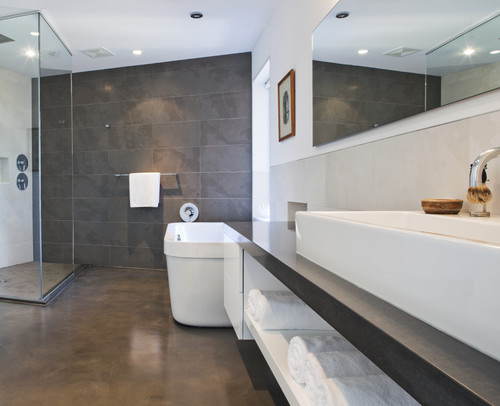Concrete is no longer the gray, drab, rough material that’s only good for pavements and handball courts. Technology now makes it possible for concrete to be stained, stamped, dyed and polished to a mirror-sheen and to resemble many other materials. This includes brick, hardwood or even natural stone like marble or granite. Some fabricators even know how to make concrete resemble leather. At the same time, concrete is far less expensive than stone. Here are some ways that it can be used to spruce up a bathroom:
All Over Concrete
Many homeowners do like the rather stark look of plain concrete and many opt for plain sinks, including long trough sinks, vanities, storage units and tubs with sharp, right angles. Gray concrete floors and gray shower stalls complete the picture, though they can be livened by pops of color or brightness such as fixtures made of polished chrome or fixtures made in unusual hues such as fire engine red or bright yellow. The severity of an all-concrete bathroom can also be softened by area rugs.
Just a Touch
Other homeowners use concrete more discreetly. A shower stall can have one wall made of concrete with a niche to hold sundries, but have a clear glass door and another wall made of pebbles or tiles made out of ceramic or glass. Another bathroom can have a simple vanity made of concrete that holds a concrete vessel sink. The vanity itself has a single shelf of rough-hewn wood to hold towels. A concrete vanity can also be made with an integral sink or sinks. This means there’s no sink to install and no chance of dirt or grime accumulating under a sink rim. Concrete sinks can even be made with built-in towel holders.
Concrete Floors
A homeowner should be mindful about using concrete as flooring. Concrete is heavy, and the floor may need to be reinforced to hold it. If the concrete is to be placed on the basement slab, there should be a vapor barrier between it and the concrete floor. Most modern homes do have a built-in vapor barrier, but if it doesn’t, the homeowner can lay one over the slab then add a self-leveling, waterproof material.
Concrete floors can be sealed to make them water resistant. Certain types of sealants add enough texture so that the risk of slips and falls is lessened. The drawback is that a concrete floor needs to be sealed every one to two years. Other than this, concrete floors are easy to care for. They just need vacuuming every week and wet or dry mopping now and then. The homeowner doesn’t have to worry about cleaning grout between the tiles or the dirt, mold or mildew that grout inevitably attracts.
Concrete is an excellent flooring material when it comes to radiant heat. HVAC professionals like those at Alair Homes Grey Bruce can install radiant heat loops beneath the surface of the concrete, and when these loops are heated they make the concrete wonderfully warm under bare feet.
